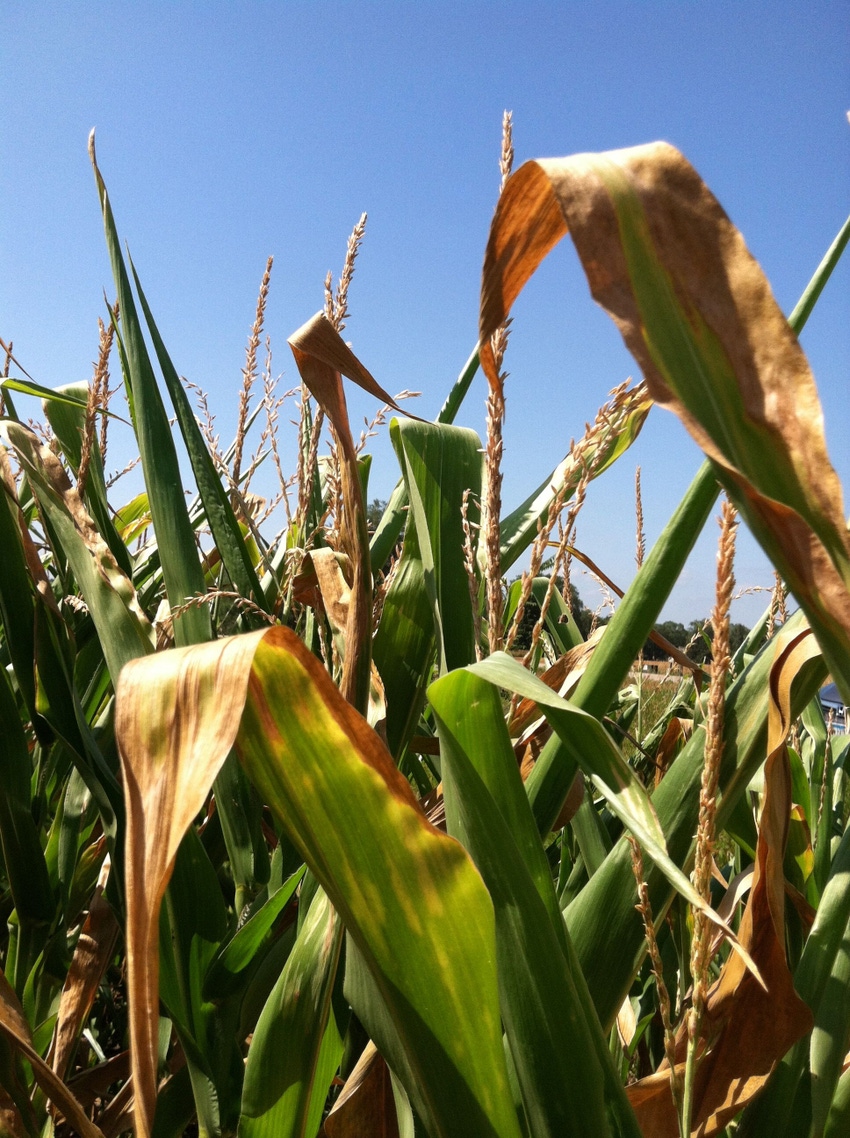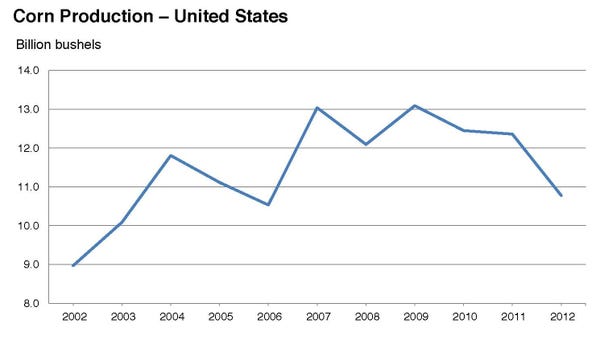August 10, 2012

Corn production is forecast at 10.8 billion bushels, down 13% from 2011 and the lowest production since 2006. Based on conditions as of Aug. 1, yields are expected to average 123.4 bu./acre, down 23.8 bu. from 2011. If realized, this will be the lowest average yield since 1995. Area harvested for grain is forecast at 87.4 million acres, down 2% from the June forecast but up 4% from 2011. Soybean production is forecast at 2.69 billion bushels, down 12% from last year. Based on Aug. 1 conditions, yields are expected to average 36.1 bu./acre, down 5.4 bu. from last year. If realized, the average yield will be the lowest since 2003. Area for harvest is forecast at 74.6 million acres, down 1% from June but up 1% from 2011.


Corn Crop Recap
The 2012 corn planted area for all purposes is estimated at 96.4 million acres, unchanged from the June estimate but up 5% from 2011. This represents the highest planted acreage in the United States since 1937, when an estimated 97.2 million acres were planted. Area harvested for grain is forecast at 87.4 million acres, down 2% from the June forecast but up 4% from 2011.
Widespread drought and extreme temperatures during June and July have had an adverse affect on the 2012 corn crop. As of July 29, only 24% of the corn acreage was rated in good-to-excellent condition in the 18 major producing states, compared to 62% rated in these two categories last year at this time. In contrast, 48% of the corn acreage was rated in very poor-to-poor condition in these same states, compared to only 14% rated in these two categories last year that this time. Eight of the major corn-producing states report 50% or more of the corn acreage rated in very poor-to-poor condition as of July 29.
The Aug. 1 corn objective yield data indicate the third highest number of ears per acre on record for the combined 10 objective yield states (Illinois, Indiana, Iowa, Kansas, Minnesota, Missouri, Nebraska, Ohio, South Dakota and Wisconsin).
Planting got off to a fast start in 2012 due to warmer-than-normal temperatures and favorable field conditions across much of the major corn-producing region. By April 1, 3% of the nation’s acreage was planted, slightly ahead of both last year and the five-year average pace. Planting was active in several major producing states during the first part of April, but producers in some locations were hesitant to begin out of concern for a potential spring freeze. Warm, dry weather continued throughout April, and producers planted at a blistering pace during the latter half of the month. By April 29, 53% of the nation’s crop was planted, 26 percentage points ahead of the five-year average pace. Fifteen percent of the acreage had emerged at this time, 9 percentage points ahead of the five-year average.
Despite Midwestern rain showers during the first part of May, growers continued planting at an above average pace. By May 6, 71% of the nation’s corn acreage had been planted, 39 percentage points ahead of last year and 24 percentage points ahead of the five-year average. Nearly one-third of the crop had emerged by this time. By May 20, 96% of the acreage was planted, which represented the quickest planting pace on record. Crop development continued at a rapid pace through the end of May due to warm weather and adequate soil moisture levels. By June 3, virtually all of the acreage had emerged.
Scarce rainfall, coupled with record-breaking temperatures, created unfavorable growing conditions during June in many of the major corn producing regions. Silking was underway by mid-month, with 5% of the crop reported in the critical reproductive stage by June 17. This was 3 percentage points ahead of both last year and the five-year average. Despite continually declining soil moisture levels, silking progressed rapidly during the latter half of the month, as sunny skies promoted crop development. By month’s end, one-quarter of the corn crop was at or beyond the silking stage, 20 percentage points ahead of last year and 17 points ahead of the five-year average. As of July 1, 48% of the corn crop was reported in good to excellent condition, compared to 72% rated in these two categories as of June 3. This represented the lowest good to excellent rating for this particular week since 1988, when only 23% of the crop was rated in good to excellent condition.
Mostly dry weather and brutally hot temperatures carried over into the first part of July in much of the Midwest, and corn conditions continued to decline rapidly. As of July 15, only 31% of the corn crop was reported in good to excellent condition, 35 percentage points below the same time last year. The above-average temperatures promoted rapid crop development. By mid-month, 71% of the crop was at or beyond the silking stage, 35 percentage points ahead of the five-year average. Twelve percent had reached the dough stage, 9 percentage points ahead of last year and 8 points ahead of the five-year average.
Although portions of the eastern Corn Belt received much needed rainfall during the latter half of the month, the moisture did little to benefit drought-affected corn since most of the crop was past the critical pollination stage. Mostly dry weather and triple-digit heat gripped the Plains and the western Corn Belt at this time. The shift of heat into the western Corn Belt could not have come at a worse time for corn entering the reproductive stage of development. This was similar to what happened in late June and early July across the lower Midwest. In contrast, enough rain fell across the northern Corn Belt to help stabilize or even improve crop conditions in some areas. As July came to an end, 94% of the crop was at or beyond the silking stage with 37% at or beyond the dough stage. Thirteen percent had reached the dented stage.
Soybean Crop Recap
Area for harvest is forecast at 74.6 million acres, down 1% June but up 1% from 2011. Harvested area, if realized, will be the fourth largest on record.
Planting conditions this spring were much improved from last year when severe flooding in several areas during April contributed to delays in soybean planting. Planting of this year’s soybean crop was underway in all 18 major states by the end of April. Heavy showers fell across parts of the northern and western Corn Belt during the first week of May, but very little precipitation occurred in the major soybean growing areas for the remainder of the month, allowing planting to remain at a pace ahead of last year and the five-year average. As of June 3, soybean planting had reached 94% complete, more than 30 percentage points ahead of last year’s pace and 19 percentage points ahead of normal.
Emergence of the soybean crop began ahead of last year and the five-year average, and remained ahead of normal pace throughout May and June. By June 17, emergence had advanced to 95%, 18 percentage points ahead of last year and 14 percentage points ahead of the five-year average. Progress for blooming and setting pods followed a very similar pattern to emergence for soybeans, as progress for both remained several points ahead of last year’s pace and the five-year average throughout June and July. As of July 29, 88% of the nation’s crop was blooming, 16 percentage points ahead of last year and 13 percentage points ahead of normal. Fifty-five percent of the acreage was setting pods by July 29, 26 percentage points ahead of last year and 20 percentage points ahead of normal.
Although hot, dry weather has helped the soybean crop mature rapidly this year, the heat and lack of rainfall has taken a toll on the condition of the crop. As of June 3, the earliest date soybean conditions have ever been published, 65% of the crop was rated as good to excellent. However, condition ratings deteriorated during June and July as drought conditions worsened across much of the Midwest. By July 29, only 29% of the crop was rated as good to excellent. This is the second lowest good to excellent rating on record for that week since records began in 1980, only better than 1988 when 24% of the crop was rated as good to excellent.
You May Also Like




